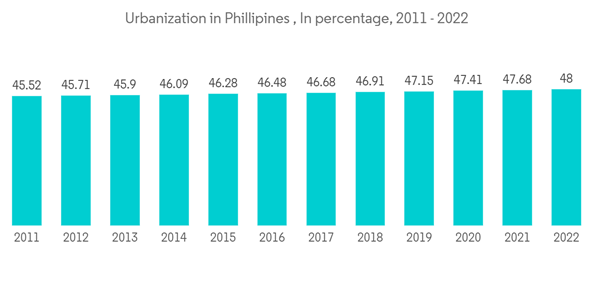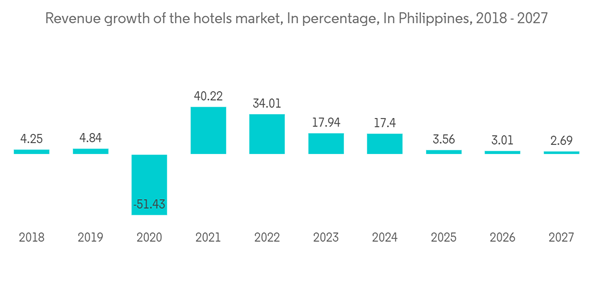The Philippines Prefabricated Buildings Industry is expected to grow from USD 12.03 billion in 2024 to USD 22.17 billion by 2029, at a CAGR of 13% during the forecast period (2024-2029).
The rise in demand for cheap housing is one of the key factors driving the prefab building market in the Philippines. There is a huge need for cheap housing since metropolitan areas are expanding and the population is growing quickly. In comparison to conventional construction techniques, prefabricated buildings are more affordable and quicker to construct. This is crucial in the Philippines, where a lot of people are having trouble finding inexpensive accommodation.
Government initiatives are another factor boosting the prefab building business in the Philippines. The Philippine government has started a number of programs to encourage the usage of prefabricated buildings. The National Housing Development Programme, for instance, plans to use prefabricated structures to construct 1.5 million dwellings by 2022. This substantial investment is anticipated to fuel growth in the prefab construction market over the next few years.
Prefabricated structures are more resistant to natural disasters than conventional structures are. Due to the Philippines' propensity for earthquakes and typhoons, buildings that can resist these occurrences are in high demand. Because they are made to be more flexible and to absorb shock, prefabricated buildings are frequently more resilient in these circumstances. This is crucial in the Philippines since natural disasters can seriously harm infrastructure and structures.
In the Philippines, the market for prefab buildings is expanding due to rapid urbanization. More housing and commercial space are required as metropolitan areas and populations expand. Prefabricated structures are gaining popularity in the Philippines as a practical answer to this issue.
As a result, commercial space is scarce in many urban areas, particularly Manila. Prefabricated buildings are more affordable and quicker to construct than traditional structures, making them an efficient and cost-effective solution to this issue.
The retail and hospitality industries have the most demand for commercial space. The Philippines' retail industry is expanding quickly because of the rising purchasing power of the middle class. The need for retail space is rising as a result, especially in urban areas. With more tourists coming to the Philippines, the hotel industry is likewise expanding quickly. As a result, demand for hotels and other hospitality structures is rising.
Government initiatives are another driver boosting the commercial building segment of the Philippines prefab building market. The Philippine government has introduced a number of efforts to encourage the usage of prefabricated buildings in the business sector.
The Philippine prefab construction market for commercial buildings is expanding due to customization as well. To fulfill the unique needs of the customer, prefabricated buildings might be altered. This is crucial for the commercial sector since firms need customized buildings for the purposes of their respective industries and operations.
This product will be delivered within 2 business days.
Key Highlights
- Demand of Prefabricated Buildings is increasing gradually with the current government’s infrastructural developments. The government’s ‘Build, Build, Build’ program around Metro Manila and other parts of the country will dictate the strategies of the real estate developers. Hence, more offices and residential units outside Metro Manila are expected to be constructed
- The COVID-19 epidemic has had a major effect on a number of global businesses, notably the building sector. The epidemic in the Philippines has had a wide range of effects on the construction sector, including supply chain interruptions, worries about employee safety, and project delays.
- Owing to the demand for construction activities in several key cities in the country, multinational corporations (MNCs) have been snapping up commercial spaces, as the country is an outsourcing destination for global companies. This creates a ripple effect on the related industries, most significantly in the flooring industry.
- Planners and architects have the option to design innovative and advanced developments of exceptional quality because of the growth in precast innovation and dimensional accuracy. Because the pieces are adaptable, the precast development method also enables engineers and designers to plan for upcoming development initiatives.
- Low-rise buildings and high-rise buildings are the two categories into which the prefabricated building market in the Philippines may be divided. Townhouses, single-family homes, and low-rise apartment buildings are all examples of low-rise structures. Mid-rise and high-rise apartment structures, as well as commercial and institutional structures, are all examples of high-rise buildings.
- In the upcoming years, low-rise structures are anticipated to hold the highest market share. This is a result of the increased demand for family and individual housing options that are affordable. Particularly well-liked housing options are single-family homes and townhouses because they provide a more open and private living space than apartments.
Philippines Prefabricated Buildings Market Trends
Rapid urbanization driving the growth of the market
The population is expanding, and urban areas are growing at an unprecedented rate in the Philippines, which is rapidly urbanizing. Due to this increase, there is a lack of residential and commercial space, and conventional construction techniques frequently cannot meet the demand. Prefabricated buildings, which provide a practical and affordable answer to the urbanization issue, have so gained popularity.The rise in demand for cheap housing is one of the key factors driving the prefab building market in the Philippines. There is a huge need for cheap housing since metropolitan areas are expanding and the population is growing quickly. In comparison to conventional construction techniques, prefabricated buildings are more affordable and quicker to construct. This is crucial in the Philippines, where a lot of people are having trouble finding inexpensive accommodation.
Government initiatives are another factor boosting the prefab building business in the Philippines. The Philippine government has started a number of programs to encourage the usage of prefabricated buildings. The National Housing Development Programme, for instance, plans to use prefabricated structures to construct 1.5 million dwellings by 2022. This substantial investment is anticipated to fuel growth in the prefab construction market over the next few years.
Prefabricated structures are more resistant to natural disasters than conventional structures are. Due to the Philippines' propensity for earthquakes and typhoons, buildings that can resist these occurrences are in high demand. Because they are made to be more flexible and to absorb shock, prefabricated buildings are frequently more resilient in these circumstances. This is crucial in the Philippines since natural disasters can seriously harm infrastructure and structures.
In the Philippines, the market for prefab buildings is expanding due to rapid urbanization. More housing and commercial space are required as metropolitan areas and populations expand. Prefabricated structures are gaining popularity in the Philippines as a practical answer to this issue.
Increasing commerical buildings in philippines prefabricated buildings market
The rising need for business space is one of the key factors influencing the growth of the commercial building sector in the Philippines' prefab buildings market. The Philippines' economy is expanding quickly, and there are more companies and startups there than ever before.As a result, commercial space is scarce in many urban areas, particularly Manila. Prefabricated buildings are more affordable and quicker to construct than traditional structures, making them an efficient and cost-effective solution to this issue.
The retail and hospitality industries have the most demand for commercial space. The Philippines' retail industry is expanding quickly because of the rising purchasing power of the middle class. The need for retail space is rising as a result, especially in urban areas. With more tourists coming to the Philippines, the hotel industry is likewise expanding quickly. As a result, demand for hotels and other hospitality structures is rising.
Government initiatives are another driver boosting the commercial building segment of the Philippines prefab building market. The Philippine government has introduced a number of efforts to encourage the usage of prefabricated buildings in the business sector.
The Philippine prefab construction market for commercial buildings is expanding due to customization as well. To fulfill the unique needs of the customer, prefabricated buildings might be altered. This is crucial for the commercial sector since firms need customized buildings for the purposes of their respective industries and operations.
Philippines Prefabricated Buildings Industry Overview
The Philippines prefabricated buildings industry is fragmented in nature, with none of the major players having a significant share to influence the market. The prefabricated and building industry is also embracing technology at a faster pace. Owing to this, construction companies are partnering with technology startups to increase productivity and efficiency. Compared to other countries, the Philippines has fewer companies in prefabricated building construction, providing an opportunity for new players to enter the market with less competition and introduce new prefabricated building structures.Additional Benefits:
- The market estimate (ME) sheet in Excel format
- 3 months of analyst support
This product will be delivered within 2 business days.
Table of Contents
1 INTRODUCTION
4 MARKET INSIGHTS AND DYNAMICS
5 MARKET SEGMENTATION
6 COMPETITIVE LANDSCAPE
Companies Mentioned (Partial List)
A selection of companies mentioned in this report includes, but is not limited to:
- iSteel Inc.
- USG Boral Building products
- Frey - Fil Corporation (FFC)
- Revolution Precrafted
- Smarthouse Corporation
- Karmod Prefabricated Building Technologies
- Toh Builders Inc.
- Indigo Prefab House
- WallCrete Company Inc.
- Prefab Philippines*
Methodology

LOADING...










